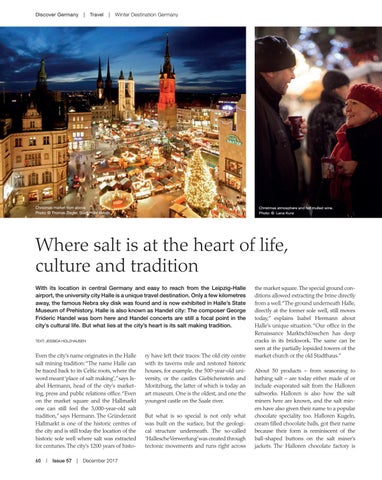Discover Germany | Travel | Winter Destination Germany
Christmas market from above. Photo: © Thomas Ziegler, Stadt Halle (Saale)
Christmas atmosphere and hot mulled wine. Photo: © Lena Kunz
Where salt is at the heart of life, culture and tradition With its location in central Germany and easy to reach from the Leipzig-Halle airport, the university city Halle is a unique travel destination. Only a few kilometres away, the famous Nebra sky disk was found and is now exhibited in Halle’s State Museum of Prehistory. Halle is also known as Handel city: The composer George Frideric Handel was born here and Handel concerts are still a focal point in the city’s cultural life. But what lies at the city’s heart is its salt making tradition. TEXT: JESSICA HOLZHAUSEN
Even the city’s name originates in the Halle salt mining tradition: “The name Halle can be traced back to its Celtic roots, where the word meant ‘place of salt making’,” says Isabel Hermann, head of the city’s marketing, press and public relations office. “Even on the market square and the Hallmarkt one can still feel the 3,000-year-old salt tradition,” says Hermann. The Gründerzeit Hallmarkt is one of the historic centres of the city and is still today the location of the historic sole well where salt was extracted for centuries. The city’s 1200 years of histo60 | Issue 57 | December 2017
ry have left their traces: The old city centre with its taverns mile and restored historic houses, for example, the 500-year-old university, or the castles Giebichenstein and Moritzburg, the latter of which is today an art museum. One is the oldest, and one the youngest castle on the Saale river. But what is so special is not only what was built on the surface, but the geological structure underneath. The so-called ‘Hallesche Verwerfung’ was created through tectonic movements and runs right across
the market square. The special ground conditions allowed extracting the brine directly from a well.“The ground underneath Halle, directly at the former sole well, still moves today,” explains Isabel Hermann about Halle’s unique situation. “Our office in the Renaissance Marktschlösschen has deep cracks in its brickwork. The same can be seen at the partially lopsided towers of the market church or the old Stadthaus.” About 50 products – from seasoning to bathing salt – are today either made of or include evaporated salt from the Halloren saltworks. Halloren is also how the salt miners here are known, and the salt miners have also given their name to a popular chocolate speciality too. Halloren Kugeln, cream filled chocolate balls, got their name because their form is reminiscent of the ball-shaped buttons on the salt miner’s jackets. The Halloren chocolate factory is
